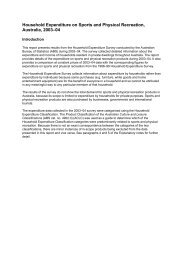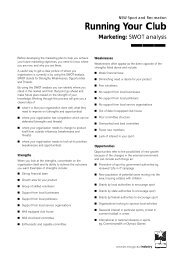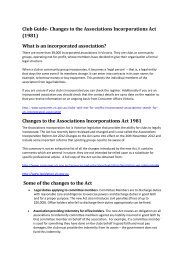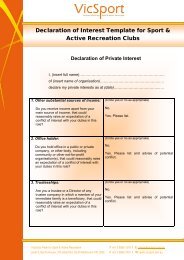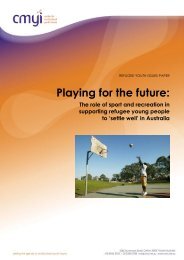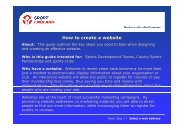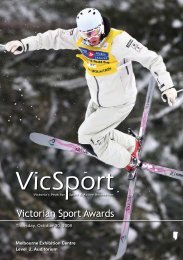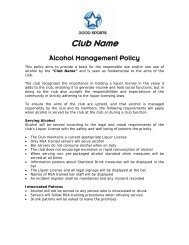Bringing Communities Together Through Sport and Culture - VicSport
Bringing Communities Together Through Sport and Culture - VicSport
Bringing Communities Together Through Sport and Culture - VicSport
Create successful ePaper yourself
Turn your PDF publications into a flip-book with our unique Google optimized e-Paper software.
BRINGINGCOMMUNITIESTOGETHERTHROUGH SPORTAND CULTUREOLDHAM 2004GOVERNMENT OFFICEFOR THE NORTH WESTGOVERNMENT OFFICEFOR YORKSHIRE AND THE HUMBERDepartment for <strong>Culture</strong>, Media <strong>and</strong> <strong>Sport</strong>, 2-4 Cockspur Street, London SW17 5DH.Designed by CravensSE/2302/10M/09/04
FOREWORDMuseums,The seminar <strong>and</strong> booklet is a partnership initiative between DCMS,Government Office North West, Government Office Yorkshire <strong>and</strong>the Humber, the Home Office Community Cohesion Unit <strong>and</strong> theregional arms of Arts Council Engl<strong>and</strong>, <strong>Sport</strong> Engl<strong>and</strong>, <strong>and</strong> theLibraries <strong>and</strong> Archives Council.<strong>Culture</strong> <strong>and</strong> sport are powerful tools for building community cohesion. Activities like football, music,dance, local history <strong>and</strong> filmmaking offer natural opportunities for people to come together <strong>and</strong>participate in community life. They break down barriers between diverse groups <strong>and</strong> can help createa sense of local pride <strong>and</strong> belonging.The Oldham event proved that authorities, agencies, <strong>and</strong> community groups are increasinglyfocused on how the arts, sports <strong>and</strong> museums can support communities in improving the qualityof local life. Practitioners are more vocal than ever before about what can be achieved <strong>and</strong> howto go about achieving it. That’s why everyone came together in Oldham <strong>and</strong> this booklet is proofpositive of the constructive <strong>and</strong> energetic debate that took place.We must now use these networks of expertise <strong>and</strong> enthusiasm to meet the changing needs ofyoung people <strong>and</strong> their communities <strong>and</strong> make cultural <strong>and</strong> sporting initiatives work in the future.I hope that the recommendations contained in this publication will support this vision <strong>and</strong> inspirepractitioners elsewhere in Britain.We will continue to work with our regional <strong>and</strong> national partners <strong>and</strong> bodies, including the HomeOffice, ODPM, DfES, the Government Offices, the Arts Council <strong>and</strong> <strong>Sport</strong> Engl<strong>and</strong> to ensure thatcommunity engagement through sport <strong>and</strong> culture flourishes.Tessa JowellSecretary of State for <strong>Culture</strong>, Media <strong>and</strong> <strong>Sport</strong>
A cohesive community is one in which there is a common vision”<strong>and</strong> a sense of belonging for all communities; the diversity ofpeople’s different backgrounds <strong>and</strong> circumstances is appreciated<strong>and</strong> positively valued; those from different backgrounds havesimilar life opportunities; <strong>and</strong> strong <strong>and</strong> positive relationships arebeing developed between people from different backgrounds inthe workplace, in schools <strong>and</strong> within neighbourhoods. 1CelebrationEvidence <strong>and</strong>EvaluationNeeds AnalysisGrowing <strong>and</strong>AdaptingPartnershipWorkingCelebrationThis booklet records the day’s discussions<strong>and</strong> highlights five aspects of using sport<strong>and</strong> culture to build community cohesion:• Needs analysis• Partnerships• Growing <strong>and</strong> adapting projects• Evidence <strong>and</strong> evaluation• Celebration.The four central themes are essential for anysuccessful <strong>and</strong> sustainable project. The fifth,celebration, is the x-factor which explainswhy communities respond so well to artistic,cultural <strong>and</strong> sporting initiatives, be it afestival or a football tournament, an artsworkshop or a museum visit, street gamesor a roadshow.This publication is aimed at practitionersacross the UK, it will deepen theunderst<strong>and</strong>ing of how culture <strong>and</strong> sport c<strong>and</strong>eliver community engagement.INTRODUCTIONThe ‘Engaging <strong>Communities</strong> through <strong>Sport</strong> <strong>and</strong> <strong>Culture</strong>’ seminar at Gallery Oldham on 4 March 2004brought together local practitioners <strong>and</strong> regional agencies from the North West <strong>and</strong> parts of Yorkshire.Almost 100 delegates discussed how arts, sport <strong>and</strong> culture have helped bring their communitiestogether as well as analysing how their experiences could be used to shape similar projects orinterventions in the future. 2The event centred on a series of workshops, where practitioners, policy makers <strong>and</strong> funders fromdifferent sectors all discussed their experiences of using sport <strong>and</strong> culture to build communitycohesion in the North West <strong>and</strong> Yorkshire.1. Working definition of a cohesive community, from the LGA Guidance on Community Cohesion, 2002. Following the disturbances in Burnley, Oldham <strong>and</strong> Bradford in the summer of 2001, a series ofreports (Denham, Cantle, Clarke <strong>and</strong> Ritchie) were published. These identified problems including deep polarisation <strong>and</strong> fragmented communities living parallel lives.The importance of Community Cohesion was identified as being crucial to promoting greater knowledge, respect <strong>and</strong> contact between various cultures <strong>and</strong> to establish a greater sense of citizenship.2. The Community Cohesion Panel’s Cultural Practitioners Group first discussed this project in June 2003. The Home Office established the Community Cohesion Panel, chaired by Ted Cantle followingthe 2001 summer disturbances.<strong>Sport</strong>ing <strong>and</strong> cultural opportunitiescan play an important part in reengagingdisaffected sections ofthe community, building sharedsocial capital <strong>and</strong> grass rootsleadership though improvedcross-cultural action.Denham Report, December 2001.
<strong>Sport</strong> <strong>and</strong> culture inspire audiences, bring peopletogether to take part in enjoyable activities <strong>and</strong>encourage individuals to think about their role in thelocal community.However, in the pressure to make decisions <strong>and</strong>allocate resources it can be all too easy to rushconsultation <strong>and</strong> planning. This can lead to the needsof a community being sidelined. Time spent workingout what your project is intending to achieve <strong>and</strong>targeting the right participants or audience is key.Be honest <strong>and</strong> realistic about timescales <strong>and</strong>achievable resultsPractitioners <strong>and</strong> community leaders must be able to follow thoughon promises. It is important to win the community’s trust <strong>and</strong> keep it.Failure to do this will lead to a loss of credibility <strong>and</strong> support.Consider the flexible use of existing facilities toaddress needsExplore options such as the multi-use of community buildings.‘An Asian Women’s Group in Kirklees who neededmeeting/activity space was encouraged to personalise a sharedroom by working with a textile artist to create personalised wallhangings which were mobile but enabled the space to bepersonalised by them whilst in their use’.1. STARTING OUT– NEEDS ANALYSISWHAT DID THE SEMINAR SAY?Know the communityProject owners should constantly focus on their prime audience but be able to adapt as target groups widen or change.Build time into your project to consult properly <strong>and</strong> underst<strong>and</strong> the area <strong>and</strong> any specific issues.‘Working with communities in Blackburn is mainstreamed. Funding bids are frowned on where they do not involvea community partner. The “Belonging to Blackburn” exhibition at the museum is an example of such a project– it was a great success <strong>and</strong> toured the borough.’Consult creativelyThis generates buy-in to the project by involving the audience <strong>and</strong> showing that you’ve actually listened to what they said.Interactive consultation through activity rather than paper is better, <strong>and</strong> arts activities can be a great way of doing this. Also,think of creative ways of sharing the results of this consultation, for example through presentations, radio or newsletters.Don’t plan in isolationLink project planning into other consultations <strong>and</strong> programmes in the area, for example, Neighbourhood Action Planning.This will help you make contact with hard-to-reach groups by taking advantage of local networks that are alreadyengaging with the community.‘Rochdale has taken a bottom up approach to programme planning <strong>and</strong> delivery that has included a communityconsultation network of 100’s of clubs <strong>and</strong> community organisations’
BRADFORD SPORT ACTION ZONEThe Bradford <strong>Sport</strong> Action Zone (SAZ) encourages inner-city residents to get <strong>and</strong> stayinvolved in sports <strong>and</strong> physical activity. But it doesn’t do this by telling people what theyshould do. Instead it asks locals to identify the problems <strong>and</strong> work with SAZ <strong>and</strong> otheragencies to develop suitable solutions.Bradford SAZ works with existing local networks, including the Bradford Trident NewDeal For <strong>Communities</strong> programme, the neighbourhood action planning process <strong>and</strong>Bradford Council’s neighbourhood forum. And it has also set up a number of specificphysical activity <strong>and</strong> consultation sessions.The first event was a daylong workshop for over one hundred residents <strong>and</strong>representatives from local agencies. In the morning session, delegates were divided intoneighbourhood groups <strong>and</strong> asked to discuss topics including:What activity <strong>and</strong> sports facilities <strong>and</strong> opportunities currently exist?What condition are they in? What stops people using them?What are the neighbourhood priorities? – with an emphasis on what’sreally needed, not limited by what might be possible.The top five priorities for each neighbourhood.After a lively lunch, people were asked to share their issues <strong>and</strong> priorities with everyone elseat the event. To people’s surprise, many issues proved to be the same – nowhere for youngpeople to play informally, few opportunities for women or girls, little perceived access toformal sports facilities <strong>and</strong> few sports coaches <strong>and</strong> instructors to run activities locally.The next step was for people from adjacent neighbourhoods to work together <strong>and</strong> to firmup priorities for their areas. At first, individual neighbourhoods wanted their own ofeverything – sports facilities, coach training programmes <strong>and</strong> so on. However, with thehelp of facilitators, negotiations between each group identified where working together<strong>and</strong> pooling resources was a more realistic approach.This local consultation helped Bradford SAZ identify their nine clear priorities:Concentrate work on the most hard-to-reach groups, for example:women <strong>and</strong> girls, disabled people;Build a database of local information – what there is to do, whatfinancial <strong>and</strong> other support is available to groups <strong>and</strong> organisations;Recruit more community <strong>and</strong> sport workers to support work beingdeveloped by local people <strong>and</strong> organisations;Create opportunities for local people to access training so they canorganise activities in their own communities;Support the development of accessible, after-school weekend <strong>and</strong>holiday activities for young people;Improve the access to good quality, local sports facilities at schools,Bradford University, Grange <strong>Sport</strong>s Centre, Fitness First;Create affordable opportunities <strong>and</strong> promote the Passport to LeisureScheme when possible;Support the need for identified small-scale capital investment tomaximise the use of existing outdoor space (for example: upgradingof pitches, changing facilities, multi-use games areas); <strong>and</strong>Encourage agencies <strong>and</strong> people in the area to work together in a moreco-ordinated way to improve communication, <strong>and</strong> pool resources <strong>and</strong> expertise.Similar local sessions were organised when Bradford SAZ extended its boundaries toinclude new neighbourhoods in 2003. Interestingly, the same issues were identified <strong>and</strong>SAZ has begun to work with residents <strong>and</strong> agencies to address them.To people’s surprise, manyissues proved to be the same
Strong <strong>and</strong> motivated partnerships, which represent the differentgroups in a community, emerge from effective local consultation <strong>and</strong>needs assessment.Some regions have seen a flurry of sports or cultural initiatives <strong>and</strong>small projects since the disturbances in summer 2001. The number<strong>and</strong> range of these projects has been positive, but has also highlightedthe need for co-ordination across agencies <strong>and</strong> organisations.‘Solid partnership development offers a better chance of making bestuse of the funding that is available’2. BUILDING AND MAINTAININGKEY PARTNERSHIPSWHAT DID THE SEMINAR SAY?Develop the infrastructureFunds should be used to build a sustainableinfrastructure which allows partnerships to grow <strong>and</strong>operate successfully beyond the funding period.‘There is a big difference between partnerships createdto ‘get funding’, <strong>and</strong> partnerships that really supportshared working <strong>and</strong> outcomes.’Explore the role of the Private SectorIn the UK we don’t develop the possibilities of partnershipbetween the voluntary, public <strong>and</strong> private sectors asmuch as we could, for example through the provision ofleisure facilities, which can provide excellent communityspaces <strong>and</strong> resources.Use community partnerships to build skills<strong>and</strong> capacityParticipation in partnerships can give people confidence<strong>and</strong> skills as well as providing a way of getting involvedwith local groups <strong>and</strong> activities. <strong>Sport</strong>s <strong>and</strong> culture canbe particularly good for this as they are seen as lesspolitical <strong>and</strong> formal.Cooperation not competitionThere were concerns that, increasingly, agencies werecompeting against each other to do the same work,rather than working in partnership. Where organisationsare joined up <strong>and</strong> can identify <strong>and</strong> work on sharedobjectives, success is more likely.Make meetings <strong>and</strong> committees dynamicTry to include young people on the committee <strong>and</strong> makesure meetings focus on action rather than rhetoric.‘Rochdale has found that success has come from engagingwith partners through activity (using activity such as sport asa way of engaging) rather than through more sterilemeetings or committees.’
BURNLEY SPORTS ALLIANCEThe Burnley <strong>Sport</strong>s Alliance (BSA) is made up of clubs, organisations <strong>and</strong> individuals whoare interested in developing sport in Burnley. Founded in November 2003, <strong>and</strong> currentlywith eleven member organisations, the Alliance is already delivering projects on the ground.In the past these projects were delivered in isolation. But coming together to form theAlliance means the participants can now share ideas, findings <strong>and</strong> good practice. They canidentify areas where there is little provision <strong>and</strong> tackle these problems together. What’smore, as a formally constituted group, they can access resources that in the past were outof reach. The benefit of working with these groups is that they are aware of local problems<strong>and</strong> needs <strong>and</strong> have experience of dealing with them. The BSA has found that the activity –rather than having meetings – is the best way to move forward.Support from the <strong>Sport</strong>s Development Unit has meant £5000 from Awards for All as wellas £1900 from the local community chest. These grants are used to run projects in areasthat the BSA identifies as hotspots as well as capacity building of all members. Or in otherwords, they give them the training <strong>and</strong> resources needed to achieve their goals.Dialogue between the diverse groups has led to the realisation that working together meansmore variety, more impact <strong>and</strong> more outcomes. By coming together, the differentorganisations don’t only deliver sporting or cultural events, but also deal with more seriousissues such as anti-social behaviour, poor health, lack of facilities <strong>and</strong> social cohesion.The BSA helps the local community organise <strong>and</strong> deliver the project themselves, whichmeans there is more chance of sustaining the project once its Active <strong>Communities</strong>Development Fund grant expires.To ensure that the BSA fulfils the needs of young people in Burnley, Burnley <strong>Sport</strong>sDevelopment (in partnership with Youth & Community) has also set up the BurnleyYouth <strong>Sport</strong>s Forum.The BSA has found that the activity– rather than having meetings –is the best way to move forward.
. ADAPTINGNDThis seminar’s popularity demonstrated the high level of enthusiasm <strong>and</strong> commitment torunning community projects using sports or culture.However, all delegates recognised that for sport <strong>and</strong> cultural activities to thrive <strong>and</strong> adapt in anenvironment of changing priorities <strong>and</strong> consumer preferences, organisations need to feeltrusted <strong>and</strong> able to take risks. Interventions have to be sustainable.ROWINGUCCESSFULROJECTSWHAT DID THE SEMINAR SAY?Help the community become proactiveThis encourages flexibility <strong>and</strong> supports sustainability.The Arts Council’s Funding Ambassadors is an exampleof an initiative which builds capacity <strong>and</strong> autonomy byusing experts to help community groups access funds.‘The best projects are when the community groupapproaches the museum with something they wishto do – not the other way round.’Promote role modelsThe lack of Asian role models in sport was cited as anexample of how this can be a problem. Role models areimportant for fostering interest among young people,<strong>and</strong> there needs to be more publicity celebrating successstories that highlight achievement by minorities.Short-term funding can create output ratherthan outcomesShort-term funding will always exist <strong>and</strong> partnershipsneed to be ready for this. Plan for results which addresscomplex, long-term issues such as changing attitudes<strong>and</strong> aspirations, thereby embedding community cohesion.Develop leadership from within the communityTraining as part of a project can develop volunteers –from play supervisors to football coaches to museumguides – so that they are more able to continue activitiesafter core funding runs out. This capacity building canhelp make interventions more sustainable.Consider transport issuesDifferent groups can be isolated from facilities or activitiesdue to bus routes. Integrating local transport into theprogrammes you run can bring in new audiences.
BE OUR GUESTBlackburn with Darwen Library Services has joined with area healthproviders to create a programme which assists asylum seekers withinformational <strong>and</strong> recreational needs. It is a cost-effective, friendlyprogramme that has grown from a library-based initiative to includeschool visits by participants <strong>and</strong> a public exhibition.‘Be Our Guest’ is simple. Pictorial flyers are sent through theborough’s asylum seekers’ forum. People arrive at the monthlyevening events clutching these flyers. Staff keep an eye out forthem <strong>and</strong> assist the families (the programme encompasses ages0-90.) to the room, where they have a cup of tea <strong>and</strong> a bite toeat. People talk in multiple languages, meeting new families,making contact with those they haven’t seen since last month.Putting dictionaries in Kurdish, Persian <strong>and</strong> Arabic on a side tableseems to have boosted confidence levels. Children play with toysprovided by the library as we sit <strong>and</strong> chat.32 people attended the first meeting of ‘Be Our Guest’ inBlackburn library <strong>and</strong>, by the beginning of April 2004, a total of 75different people had attended four meetings.The first hour is devoted to the library-orientated aim of theevening: promote library services to a group of people frombackgrounds where asking questions about government serviceswas not a good idea. Information travels on casual waves of chat,aided by the unfailing bond of eating together. In response to aquery about contacting home, staff explain that the library hasfree internet access <strong>and</strong> also offer free computer courses. When awoman says she’d like to learn English at home she is shownlanguage cassettes <strong>and</strong> helped, among sign language <strong>and</strong>giggles, to fill in a membership form so that she can borrow them.By the time the programme starts, people are on first-name basis<strong>and</strong> even those with little English feel relaxed.The second hour is devoted to storytelling, <strong>and</strong> the health-oriented outcome target:help people who are asylum seekers feel comfortable speaking in public, in orderto assist them in telling their own stories, protect self-esteem <strong>and</strong> alleviateboredom <strong>and</strong> stress. The group plays storytelling games, talking in small <strong>and</strong> largegroups about their homel<strong>and</strong> <strong>and</strong> hostl<strong>and</strong> lives using directed activities.‘Be Our Guest’ has successfully exp<strong>and</strong>ed with a programme of visits toschools <strong>and</strong> other venues to speak about life in other countries. It alsopromotes the School Library Service’s Cultural Harmony pack, put togetherby those members who are confident at speaking in public, including peoplefrom Burundi, Jamaica, Turkey <strong>and</strong> Iraq. By early April they had visited 10schools, a Mental Health Resource Centre <strong>and</strong> a Rotary Club. Children askedmany questions including ‘Why did you leave Turkey? I went on holiday there<strong>and</strong> no one was mean to me’ <strong>and</strong> ‘Why don’t people like Kurdish people?’Adult responses to the group have also been overwhelmingly positive. Onehead teacher, Marjorie Owen said ‘What an amazing resource! We’re verygrateful to you <strong>and</strong> to the library service for providing us with thisopportunity’. This programme is ongoing.A third prong of the programme is reaching its climax as it prepares forRefugee Week. Darwen Library Theatre will host an evening entitled‘Sanctuary’ featuring personal experience narratives, observations, songs<strong>and</strong> sketches exploring issues of safety <strong>and</strong> belonging.‘Be Our Guest’ has aroused interest from other Borough services, includingBlackburn with Darwen’s Social Services department, <strong>and</strong> from other librarysystems in Bolton <strong>and</strong> Hull.Information travels on casual waves of chat,aided by the unfailing bond of eating together
4. EVALUATIONAND EVIDENCEGATHERINGWHAT DID THE SEMINAR SAY?CategorisationThere are concerns that st<strong>and</strong>ard reporting formats don’t tiein with how the public actually express themselves in termsof identity <strong>and</strong> ethnic origin. Furthermore, how can we besure that we are genuinely reaching new audiences <strong>and</strong> notsimply talking to the same groups again <strong>and</strong> again?‘How do we measure different participation in sports?And how do we encourage more engagement?’Measuring attitudes <strong>and</strong> opinionsThis is a key part of assessing the impact of sport <strong>and</strong>culture on the local community. It was felt that measuringchanges in attitude is one of the most difficult things todo, especially when attitudes <strong>and</strong> values of individualscan be very different to what is expressed by groups.The Youth Service measures attitude change, but shouldwe be looking at the feelings of the wider community, forexample through customer perception surveys?‘Charting young people’s opinions <strong>and</strong> attitudes is hardbecause this can change by the day – so how <strong>and</strong> whendo you measure the impact?’Reduce the burden on small organisationsHow do we make it easier for small projects to evaluatetheir success? Also funders need to be aware that tightproject timescales can hamper meaningful evaluation,making it feel forced. Can we make feedbackmeasurement more responsive <strong>and</strong> simple?Clear ownership of long-term trackingA commitment to tracking results over time is essentialto ensure that lessons are genuinely learnt, shared <strong>and</strong>acted upon.‘It can feel like we are always doing exit strategies’.Qualitative workCase studies alone do not prove cost-effectiveness.Qualitative analysis of outcomes is required. Is thiswhere customer perception surveys come in again?Gathering numbers <strong>and</strong> profiles of individuals who takepart in largely voluntary sport <strong>and</strong> cultural activity isproblematic to say the least. Evaluation <strong>and</strong> evidencegathering can help practitioners <strong>and</strong> groups target theright people <strong>and</strong> therefore build cohesion in thecommunity. Stronger evidence convinces funders, policymakers <strong>and</strong> local people that sport <strong>and</strong> arts are healthy<strong>and</strong> fun ways to make places better, <strong>and</strong> not a soft option.Practitioners are calling for a fresh look at how weprove impact, which can take account of the hard <strong>and</strong>soft outcomes of community activities.‘The work – arts <strong>and</strong> sport – is there to ‘switch the lighton’ in people’s heads.’
The evaluation methods <strong>and</strong> aims were set out an early stage. This helped to give the project greater focus <strong>and</strong> allowedprogress to be monitored <strong>and</strong> tweaked continually – rather than finding things out after the project had ended. Themethodology used included Learning Matrices <strong>and</strong> a questionnaire, both based on the GLOs . The questionnaire wasmore successful in determining feelings of participants <strong>and</strong> worked particularly well when asked in person as opposed tobeing provided in a written context. We wanted to achieve a balanced view of the project <strong>and</strong> so asked everyone whotook part (project workers <strong>and</strong> yurt-builders too, not just the group members).The overall feedback was incredibly positive <strong>and</strong> strengthened the case for outreach project work within museums<strong>and</strong> galleries. The questionnaire recorded the following experiences:71% of participants felt that the project encouraged them to feel differently about otherpeople (have a greater awareness of other cultures <strong>and</strong> communities).100% of participants learnt a new skill, from felt-making to video editing.MOVING MINDS:EVIDENCE AND EVALUATION85% of participants had a more positive opinion of the museum/gallery having been involved in theproject <strong>and</strong> intend to visit again. The remainder had the same opinion or gave a neutral response.There were no negative responses.78% of participants said it changed their outlook for the future.92% of participants said they would like to do a similar project again in the future.3. The Generic Learning Outcomes (GLOs) are a new research tool to measurelearning which have been developed by the. GLOs help to:• Analyse work <strong>and</strong> tell stories about its impact on individuals <strong>and</strong> communities• Talk to colleagues, funders, evaluators <strong>and</strong> policy-makers about learning in alanguage that they share <strong>and</strong> underst<strong>and</strong>• Design better learning experiences <strong>and</strong> spaces that inspire people to learn• Reinforce for users the significance of their learning experiences.The GLOs provide a framework for assessing evidence of learning <strong>and</strong> can be used to:• Improve approaches to evaluation• Analyse <strong>and</strong> draw conclusions about learning from existing data• Develop staff <strong>and</strong> governing bodies awareness of <strong>and</strong> practice in learning• Transform the way that we to talk to users <strong>and</strong> visitors about learning.The aim of ‘Moving Minds’ was to bring together museums <strong>and</strong> galleries from Bradford, Leeds <strong>and</strong> Manchester withcommunities <strong>and</strong> artists to create work that reflects their ideas on migration, culture <strong>and</strong> identity. Community groupsused the collections of the participant museums to stimulate discussion about their lives today <strong>and</strong> in the past. Theevaluation was built around the highly innovative Generic Learning Outcomes (GLOs), which form part of the ‘InspiringLearning For All’ framework which was launched by the Museums Libraries <strong>and</strong> Archives Council in March 2004.Themes for exploration ranged from leaving home, songs, dance <strong>and</strong> storytelling, cooking <strong>and</strong> food, prejudice <strong>and</strong> belief,danger <strong>and</strong> safety, environment <strong>and</strong> architecture. The groups also worked collaboratively to build a modern gur (yurt) to housetheir displays. Yurts are lightweight structures that can be constructed <strong>and</strong> moved easily; they originated in Mongolia wherenomadic peoples designed them as simple <strong>and</strong> easily moveable homes. Today, modern yurts are used by aid agencies tobuild refugee camps, hospital stations <strong>and</strong> temporary schools so they are particularly apt structures for this project.The purpose of evaluating the project was to gain insight into the following areas:If, what <strong>and</strong> how people learn through engagement withmuseums <strong>and</strong> galleries.The value of outreach work <strong>and</strong> community based projectsin audience development fo the museum/gallery.The benefits <strong>and</strong> challenges of working in creativepartnerships.The overall feedback was incrediblypositive <strong>and</strong> strengthened the casefor outreach project work withinmuseums <strong>and</strong> galleries.
Community celebration, such as street festivals<strong>and</strong> events organised by museums, galleries,sports stadiums <strong>and</strong> so on, is a brilliant tool forcommunity engagement simply because peoplehave fun. The question is: how do we keep thesecelebratory activities refreshed <strong>and</strong> energisedover the years? And how do practitioners enablepeople to build on these activities <strong>and</strong> tackleother issues <strong>and</strong> needs in their communities?CELEBRATIONWHAT DID THESEMINAR SAY?Enable small-scale spontaneouscommunity celebrationCould there be a spontaneity pot withminimal bureaucracy for communitycelebration? There aren’t enough simple,small funding schemes which aren’t tiedto large agencies.Make the most of cultural orsporting institutionsIf people feel that agencies <strong>and</strong> publicbodies are not receptive to ideas,because they are pursuing their ownagendas, they will feel demotivated.How do we encourage more meaningful<strong>and</strong> genuine engagement? Onesuggestion was to channel fundingtowards moving arts <strong>and</strong> heritage out oflarge institutions <strong>and</strong> into communitieswhere this doesn’t happen already.‘Manchester Museum recognised that theimage of the museum as academic <strong>and</strong>exclusive can be off-putting. So they havereached out to communities directly inorder to break down these perceptions.’‘Should there be some sort of ‘compulsion’for large private sector organisations tosupport grass-roots activity, some kind ofCorporate Social Responsibility?’Measuring enjoymentHow do we really monitor increases inlocal pride or happiness generated bycommunity celebration? Why can’tthirty smiling faces be an indicator?What about curiosity <strong>and</strong> imaginationor improvements in behaviour?Quality of experienceDon’t dumb down the experience.Take full account of the culturalheritage of the community <strong>and</strong>,where possible, avoid copyingother initiatives.‘How do we grow talent <strong>and</strong> diversity inthe Arts when funding is so specific?’
LARK IN THE PARKThe Friends of Mercer Park is a group of local activists in Clayton le Moors,Lancashire. Its aim is to encourage local people to make more use of thepark <strong>and</strong> to enhance its facilitiesEvery year they hold an annual arts festival, ‘Lark in the Park’.It uses both visual <strong>and</strong> performing arts to bring together a culturally diversecommunity in Clayton-le-Moors. People of all ages are given the opportunityto use art to address issues of exclusion <strong>and</strong> challenge stereotypicalattitudes <strong>and</strong> values.A ‘Holiday Arts’ <strong>and</strong> sports activity programme runs for four weeks before the‘Lark in the Park’ festival starts. This raises the event’s profile <strong>and</strong> gets thelocal community involved. Arts activities are led by professional artists,leading to shared learning <strong>and</strong> high quality work. ‘Holiday Arts’ <strong>and</strong> ‘Lark inthe Park’ combine to transform Mercer Park into a place which celebratesachievement, challenges prejudice <strong>and</strong> works inclusively.The number of people taking part in the workshop programme <strong>and</strong> attendingthe festival has steadily risen. So has the number of people involved in itsactual organisation. In just two years, the number of volunteers who run theevent, has risen from 15 to 40; while the organising group has increased innumber from eight regular attendees to 15, representing all ages.The event has had a longer-term impact too. In conjunction with HyndburnBorough Council, a parks management plan has been approved which hasalready created a new dual-use play area. Funding bids to develop a sculpturalsensory garden in the park have also been forwarded by the Friends.Celebration has made a big difference to the development of the Friends ofMercer Park. It has also given the wider community a sense of pride, place<strong>and</strong> belonging. Groups of people <strong>and</strong> individuals of different ages <strong>and</strong> culturalroots work together <strong>and</strong> explore common ideas. Existing skills within thecommunity are identified, used <strong>and</strong> extended while new ones are developed<strong>and</strong> shared with others.Celebration has given the wider communitya sense of pride, place <strong>and</strong> belonging.
BUILDING ON THEThis booklet outlines practical points to consider when running sport <strong>and</strong> cultural projects toachieve increased community cohesion. It is available to local authorities throughout Engl<strong>and</strong>to spread best practice. However, it can also provide significant learning for centralgovernment <strong>and</strong> regional cultural <strong>and</strong> sporting agencies.LEARNINGSO, WHAT ARE THE KEY MESSAGES TO TAKE FORWARD?We have seen how sport <strong>and</strong> culture can reach out to different groups in communities but the Oldham seminar focusedmore on the future than what has already been achieved.Delegates had some simple <strong>and</strong> powerful messages for practitioners, funders <strong>and</strong> policy makers at all levels:Too much work using sport <strong>and</strong> culture is still focused on output rather than outcome.There is a need to explore the role of the private sector, especially in delivering quality leisure services.Partnerships which can support small projects <strong>and</strong> sustain activity over the longer term need to bestrengthened. Lessons can be learnt, for example, from influential sports networks.Large organisations <strong>and</strong> central government need to be more responsive to local needs <strong>and</strong> the grassroots desire to use sport <strong>and</strong> culture.Can we find better indicators to measure increases in civic pride, well-being <strong>and</strong> smiley facesthrough taking part in culture <strong>and</strong> sport?How do we engage hard to reach groups <strong>and</strong> what part can role models play?
ANDFINALLY...HOW CAN WE USE THESE MESSAGES TO INFLUENCE CENTRALGOVERNMENT AND LEAD AGENCIES?As the lead department for sport <strong>and</strong> culture, DCMS will build on the work with its agencies (including <strong>Sport</strong> Engl<strong>and</strong>, Arts CouncilEngl<strong>and</strong>, the Museums, Libraries <strong>and</strong> Archives Council, English Heritage <strong>and</strong> the Lottery) <strong>and</strong> key departments such as the Home Office<strong>and</strong> ODPM in order to support grass roots initiatives <strong>and</strong> local needs more flexibly.At the same time the Community Cohesion Unit (CCU) in the Home Office is encouraging <strong>and</strong> facilitating new learning through theCommunity Cohesion Pathfinder Programme, aimed at building real life examples of areas that are getting community cohesion right.The Oldham seminar will be used to inform the following cross-governmental work which contributes to the community cohesion agenda:The question of more relevant indicators for sport <strong>and</strong> culture will be considered as part of the DCMSnegotiations on how local authorities will be measured on cultural <strong>and</strong> leisure services in future,through the new Comprehensive Performance Assessment for local government.Anti-social behaviour. Poor health. Social <strong>and</strong> cultural exclusion. Yes, the Oldham eventtouched on some of the most serious topics that affect today’s society.But the event itself proved that there’s a way ahead. That, by talking together – <strong>and</strong> by listeningas well – people from different backgrounds can find common ground <strong>and</strong> ways to progress.Above all, it’s that ‘X-Factor’, the sense of celebration, that can really make a difference to thesuccess of social cohesion projects.How reassuring that some of the toughest social issues facing us can be confronted bysomething so unscientific: fun.DCMS <strong>and</strong> its agencies will look at engaging the hard to reach groups in different communitiesthrough a new Beacon Council theme which aims to identify the best performing authorities whocan act as centres of excellence from which other authorities can learn.DCMS <strong>and</strong> the Home Office (Civil Renewal Unit) will work together to see how communityengagement through sport <strong>and</strong> culture can build civil renewal.DCMS <strong>and</strong> the Neighbourhood Renewal Unit will continue to cooperate on joint initiatives such as theNew Deal for <strong>Communities</strong> study <strong>and</strong> the contribution of sport <strong>and</strong> culture to floor targets.The issues raised around flexible <strong>and</strong> quick funding for sport <strong>and</strong> cultural initiatives will be fed intoconsultation on the remit of the Big Lottery Fund, which has taken over the functions of the NewOpportunities Fund <strong>and</strong> the Community Fund, <strong>and</strong> other Lottery distributors.
PARTICIPANTSNAMEORGANISATIONNAMEORGANISATIONAbdul BasitOldham Athletic FC LimitedRichard LambertOldham MBCRichard BealingKirklees MBCRebecca LinleyThe Council For Museums, Archives & LibrariesJim BeattieLee BowyerLeila BrosnamAndrew BrownSimon Butler*Kevin ByrneKaren CarterChristine ChadwickNeil ConsterdineMichelle DewAndrea DixonChris DoddJulian DunnJulie DurrantJulie AllsopIsmail EsatDonna FermanKashaff FerozeAndrew FlemingNick FordSteve Hassall*Barry HealeyKaren HicklingRebecca HiltonBilly HughesNick HuntMalik IkramPeter JacksonMagda JenkinsBernadette LynchSam KeighleyFareda KhanKirklees MBCHyndburn Borough CouncilDCMSHome OfficeTower Hamlets Active <strong>Communities</strong> <strong>Sport</strong>s PartnershipDCMSRossendaleNorth West Museums, Libraries & ArchivesFitton Hill CPDHyndburn Borough CouncilLancashire <strong>Sport</strong><strong>Sport</strong> Engl<strong>and</strong>Action Factory Community Arts LimitedRochdale MBCSalfordAsian <strong>Sport</strong>s Engagement Project, BlackburnDoncaster CouncilPendle Pakistan Welfare AssociationHome Office, Community Cohesion UnitOldham MBCSalford Community Leisure Limited<strong>Sport</strong> CheshirePrescapArts Council Engl<strong>and</strong>, North WestManchester Youth ServiceMid Pennine ArtsPendle Pakistan Welfare AssociationRochdale Borough CouncilDoncaster MBCManchester MuseumBradford <strong>Sport</strong> Action ZoneShishaSheena MacfarlaneJanet MatthewmanChris MayDavid GaffneyAnayat MohammadNorma MonksKevin MooreAdrian MorrisJane MossJoanne MossNyla NaseerAnnie O’NeillKarl OxfordAndy PearceGail PorterAm<strong>and</strong>a PotterKatherine RhodesJackie RiddellKate RodenhurstCarol RogersMick SheeranPhilip ShirfieldLisa StaceyRichard SutcliffeGary ToppChristine TrennelMalcolm TungattAmy WardGary WhiteStephen WhittleNeil WitneyGallery OldhamGONWArts Council Engl<strong>and</strong> North WestArts CouncilELPBlackburn With Darwen Borough CouncilNational Football MuseumManchester Youth ServiceHome Office, Civil Renewal UnitLancashire <strong>Sport</strong>English HeritageOldham Arts <strong>and</strong> Events, Oldham MBCGOYHTouchstones RochdaleGONWGOYHOldham LEABurnley Youth TheatreNational Museums LiverpoolNational Museums LiverpoolDfES<strong>Sport</strong> Engl<strong>and</strong>Fitton Hill CPD<strong>Sport</strong> & Community Recreation – SheffieldYorkshire <strong>Culture</strong>Oldham <strong>Sport</strong>s Centre<strong>Sport</strong> Engl<strong>and</strong>DCMSLiverpool <strong>Sport</strong> Action ZoneGallery OldhamNeighbourhood Renewal Unit, ODPMIbby KhanBurnley Borough CouncilAndy WiggansRochdale MBCJimmy KhanPreston Borough CouncilSharon WilkinsonGONWOmar KhanPreston RECSue WilkinsonMLAJohn KnightonTameside MBCDot WoodM6 TheatreTHE STEERING GROUPAndrew BrownHome Office, Community Cohesion Unit*Am<strong>and</strong>a PotterGovernment Office Yorkshire <strong>and</strong> Humber, DCMSChris ChadwickNorth West Museums Libraries <strong>and</strong> Archives CouncilRachel Roberts<strong>Sport</strong> Engl<strong>and</strong>*Sam KeighleyBradford <strong>Sport</strong> Action Zone*Philip Shirfield<strong>Sport</strong> Engl<strong>and</strong> NWKarl OxfordGovernment Office Yorkshire <strong>and</strong> Humber, Home OfficeDave Spence<strong>Sport</strong> Engl<strong>and</strong> Yorkshire <strong>and</strong> HumberJanet MatthewmanGovernment Office North West, DCMSAmy WardDCMS* (Chair)Chris MayArts Council Engl<strong>and</strong>, North WestSharon WilkinsonGovernment Office North West, Home Office*Representatives on the Community Cohesion Panel’s Cultural Practitioners Group, chaired by Kimiyo Rickett.OTHER READINGTeaming Up www.neighbourhood.gov.ukNDC Involvement in Arts, Leisure <strong>and</strong> <strong>Sport</strong>s www.ndcevaluation.adc.shu.ac.ukCommunity Cohesion Pathfinder Programme - The First Six Months www.homeoffice.gov.uk/comrace/cohesionActive Citizens, Strong <strong>Communities</strong>: Progressing Civil Renewal. London: Home Office Communication Directorate, 2003Guidance on Community Cohesion www.lga.gov.ukSPECIAL THANKSGallery Oldham.Civil Renewal Unit <strong>and</strong> Community Cohesion Unit at the Home Office for part-funding the booklet.<strong>Sport</strong> Engl<strong>and</strong> for coordinating the booklet print <strong>and</strong> production.ACKNOWLEDGEMENTSConference photos - Matt Gartside of Zumamedia Arts, Colne, LancsThanks to all the projects, local authorities <strong>and</strong> agencies who generously contributed photos <strong>and</strong> case studies to this booklet.



